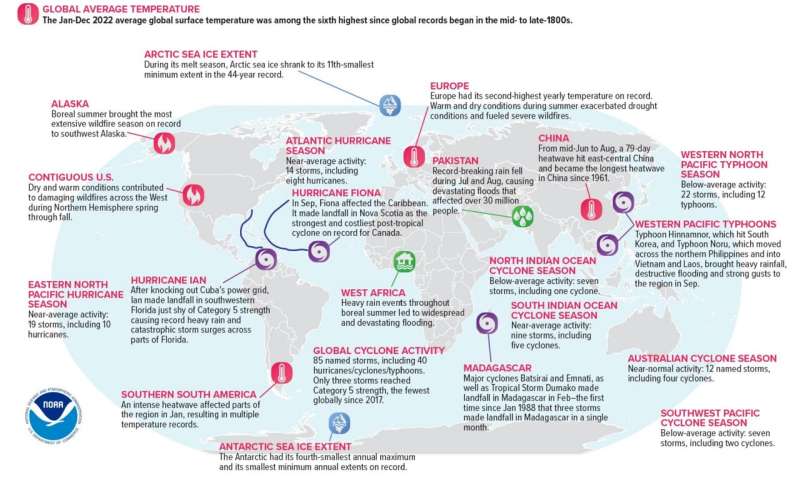This article has been reviewed according to Science X's editorial process and policies. Editors have highlighted the following attributes while ensuring the content's credibility:
fact-checked
peer-reviewed publication
trusted source
proofread
Heat waves are hitting Antarctica too now

The world saw another year full of extreme weather events resulting from climate change in 2022, from intense storms to soaring temperatures and rising sea levels. Antarctica was no exception, according to new research published this week.
In the 33rd annual State of the Climate report, an international assessment of the global climate published Wednesday in the Bulletin of the American Meteorological Society, CU Boulder researchers report that the planet's coldest and driest continent experienced both an unprecedented heat wave and extreme precipitation last year.
"My hope is that the public starts to see both the fragility and complexity of these polar regions," said Rajashree Tri Datta, a research associate in the Department of Atmospheric and Oceanic Sciences who contributed to sections of the report related to Antarctica and the Southern Ocean.
While Antarctica may seem isolated from the rest of the world, changes to the icy continent could significantly impact the rest of the world.
"Most of the planet's fresh water is held on the ice sheet of Antarctica. What happens there ends up affecting coasts across the world, and what affects coasts across the world impacts everything from agriculture to migration patterns," Datta said.
In recent years, scientists have observed rapid sea ice decline and enhanced warming there. Regions of Antarctica, such as the West Antarctic Ice Sheet, have started to lose ice rapidly, contributing to sea level rise.
Datta and her team report that for six days last March, a large region of East Antarctica experienced temperatures exceeding 18 degrees Fahrenheit (10 degrees Celsius) above the historic March average from 1991 to 2020. The temperature recorded at a weather station in the interior of East Antarctica reached a record-breaking 14.7 F (-9.6C) on March 16, 2022, more than 79 F (44 C) higher than the average March temperature at that location.
Normally, March marks the transition from summer to winter in Antarctica, and the temperature drops rapidly. Following the heat wave, the Conger Ice shelf, a floating tongue of ice the size of Rome, collapsed in East Antarctica. This ice shelf had become increasingly vulnerable over the years. The collapse of floating ice shelves can often hasten the loss of upstream glaciers, resulting in ice loss and sea level rise.
As people around the world also experienced more frequent and intense heat waves in 2022, Datta said the team's research provides an opportunity to communicate with the public about climate change in Antarctica in a way that resonates with them.
"They know what a heat wave means. They experience it in their daily lives, and it is impacting Antarctica as well, although in very different ways" Datta said.

Unprecedented snowfall too
East Antarctica also saw an unprecedented amount of snowfall last March, tripling the month's mean precipitation in some locations compared with the March average between 1991 and 2020. As a result, the annual balance of snow and ice retained on the surface of the ice sheet reached the highest value in the 40 years since the observational data became available.
"The strong precipitation this year is very interesting, because it offsets the ice loss around the margins of Antarctica," Datta said. "The snowfall this year actually protected the world against sea level rise."
Weather phenomena called atmospheric rivers—much like those that fueled record flooding in California this year—contributed to both the heat wave and the record precipitation, Datta said. These storms pull moisture from lower latitudes and delivered warm air and a large amount of precipitation to Antarctica in 2022.
While precipitation in Antarctica typically takes the form of snow, changes in these atmospheric rivers could bring enough heat to contribute to more surface melt or bring rain instead in the future, driving sea levels higher and impacting billions of people around the world, she said. Greenland, which is much warmer than Antarctica, is already experiencing many of these impacts.
The State of the Climate report, a collaboration of more than 570 international scientists, also reported that Earth's greenhouse gas concentrations reached a new record last year. The global annual average atmospheric carbon dioxide concentration was 50% greater than the pre-industrial level, the highest measured amount in modern observational records. The amount of heat stored in the ocean continued to increase, as did global sea levels, reaching about 4 inches on average above the 1993 mean.
In another section of the report, Twila Moon, the deputy lead scientist at the National Snow and Ice Data Center at CU Boulder, reported that weather pattern shifts are also affecting the planet's other pole.
"Observations over the past forty-plus years show a transition to a wetter Arctic, with seasonal shifts and widespread disturbances influencing the flora, fauna, physical systems, and peoples of the Arctic," Moon and her team wrote.
"The report adds pieces to the larger puzzle of how climate change can impact Antarctica," Datta said. "Many of these dramatic events in 2022, and further research into their causes and effects, can arm us with a better understanding of our potential future."
More information: ametsoc.net/sotc2022/SOTC2022_FullReport_final.pdf
Journal information: Bulletin of the American Meteorological Society
Provided by University of Colorado at Boulder




















